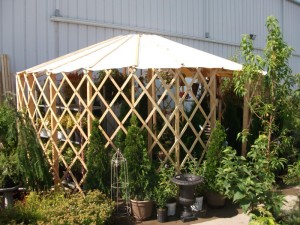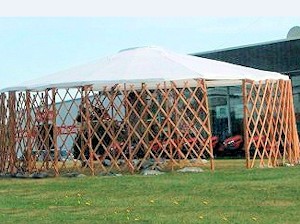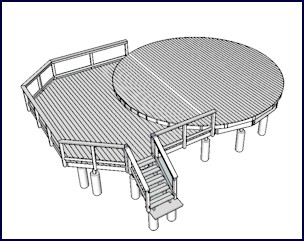Planning your yurt
Click here for the main Yurt homepage
You can download Yurt construction manuals in PDF format below
 |
 |
 |
 |
|
| Build your own Yurt | Building a Mongolian Yurt | Mongolian Yurt part 1/2 | Mongolian Yurt part 2/2 |
|
To view how you can build a simplified yurt structure, click here or on the image above |
For an example of a 25-foot simplified yurt, click here or on the image above
|
For information on decks for yurts, click here or on the image above
|
The following is a summary of what to consider before purchasing materials. As always, the intended use of your yurt will define certain features that are essential and practical.
Directly on the ground or on a platform?
This depends on your intended use plus your budget and how fancy and durable you want your yurt. A wood deck or platform may be something you already have experience building (or your friend does…). If you plan to transport your yurt to different locations then a deck is not justified. A thick canvas or tarp on the floor can be enough. In any case you need to ensure that water does not come inside the yurt.
How big will your yurt be?
Similarly to a geodesic dome, doubling the diameter of the yurt increases the area’s square footage four-fold.
For example:
A 20-foot diameter yurt has 314 square feet of area
A 40-foot yurt, twice the diameter, has 1256 square feet of area
In regards to materials, they do not increase four-fold, but you will have to take into consideration that your rafters, walls, crown and tension bands meet the requirements for a bigger and heavier structure. To maintain structural integrity, you will need more rafters and therefore a crown with enough holes to attach them to it.
Figuring out desired height
A standard door is 80 inches, adding 3-4 inches for the frame. Since 8-foot studs are the most common length, you have some play as to how high you can make your walls. 7 feet is often a height used for the kahna (wall).
Naturally this will affect the trellis construction. The more dense your trellis is, the stronger it becomes. This in turn will increase the number of rafters (roof ribs).
Choice of door
Since you are most likely to build a yurt from timber, using a door with a frame already built around it can save you time. You can bolt or nail the kahna to the frame; no curved cuts required so you can use a standard saw.
Choice of canvas cover
Two main considerations: waterproofing and ventilation. A waterproof covering is usually coated with a product that does not breathe (just like a raincoat) and therefore increase moisture levels inside the yurt. To solve this, ventilation in the form of windows or openings are necessary, preferably the kind that you can zip open or shut just like in a tent. If you can get a door with a window that opens, even better.
There is one major benefit to make your own cover: the simplicity of cutting the pieces; the walls are the easiest to make since they’re basically square. As for the roofing it’s the same pattern repeated all around. Where you may need help is in joining pieces together. Depending on the thickness of the fabric you may be able to sew on a regular sewing machine. If too thick then a commercial sewing machine. will do the job.
Two types of fabric are most popular: pure cotton and 50/50 cotton polyester blend. Of course either one is attractive yet unless treated with a product such as silicone it will be a weak waterproofing cover. You can find both fabrics in different weights such as the standard 12oz or 15oz. The thicker, the more lasting it is.
Ideally you should look for a canvas which is water resistant or waterproof, rot resistant and last but not least, fire retardant. Without that last characteristic your canvas could go up in flames in minutes.
For additional insulation you can opt to add a liner to your cover. This is especially useful in cold weather.
Windows
Since a typical yurt is made with a wooden trellis for a wall (kahna) you can adapt various off-the shelf windows or make one of thick pliable plastic with an optional zipper.
Heating your yurt
Depending on local fire safety regulations and building code, adding a stove is something you may want to consider. This can make your yurt comfortable year-round. A small unit with a regulation installation is fairly simple to install, but again, consult safety and building regulations.





